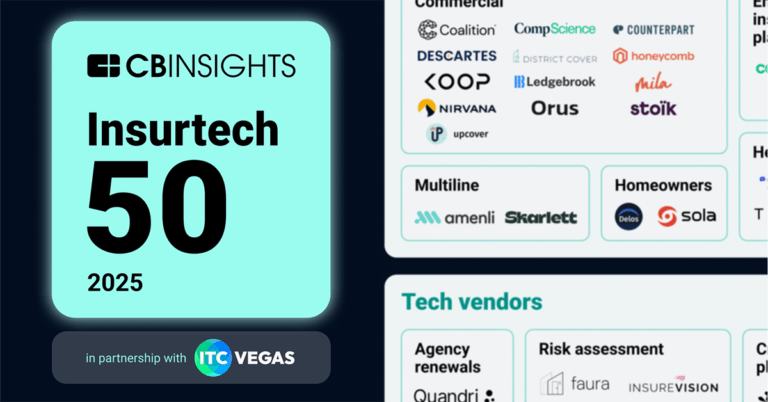
Honeycomb
Founded Year
2019Stage
Series B | AliveTotal Raised
$54.7MLast Raised
$36M | 2 yrs agoMosaic Score The Mosaic Score is an algorithm that measures the overall financial health and market potential of private companies.
-8 points in the past 30 days
About Honeycomb
Honeycomb is a company focused on the real estate insurance industry through digital means. It offers various insurance products including landlord, apartment building, condo association, and homeowner association insurance, tailored to the needs of property owners, managers, and associations. Honeycomb serves the real estate sector with its digitally-native platform that provides customizable coverage options. Honeycomb was formerly known as Agilius Insurance Services. It was founded in 2019 and is based in Chicago, Illinois.
Loading...
Loading...
Research containing Honeycomb
Get data-driven expert analysis from the CB Insights Intelligence Unit.
CB Insights Intelligence Analysts have mentioned Honeycomb in 1 CB Insights research brief, most recently on Oct 16, 2025.

Oct 16, 2025 report
Insurtech 50: The most promising insurtech startups of 2025Expert Collections containing Honeycomb
Expert Collections are analyst-curated lists that highlight the companies you need to know in the most important technology spaces.
Honeycomb is included in 8 Expert Collections, including Real Estate Tech.
Real Estate Tech
2,494 items
Startups in the space cover the residential and commercial real estate space. Categories include buying, selling and investing in real estate (iBuyers, marketplaces, investment/crowdfunding platforms), and property management, insurance, mortgage, construction, and more.
Insurtech
4,636 items
Companies and startups that use technology to improve core and ancillary insurance operations. Companies in this collection are creating new product architectures, improving underwriting models, accelerating claims and creating a better customer experience
Fintech
9,809 items
Companies and startups in this collection provide technology to streamline, improve, and transform financial services, products, and operations for individuals and businesses.
Smart Cities
1,148 items
ITC Vegas 2024 - Exhibitors and Sponsors
699 items
Created 9/9/24. Updated 10.22.24. Company list source: ITC Vegas. Check ITC Vegas' website for final list: https://events.clarionevents.com/InsureTech2024/Public/EventMap.aspx?shMode=E&ID=84001
Artificial Intelligence (AI)
20,894 items
Latest Honeycomb News
Oct 29, 2025
The market is softening for most asset classes, not all – what does this mean for brokers? Share After a hard market period, commercial property insurance is seeing improvements in capacity and rate reductions across many regions and asset classes. However, industry leaders warn that the recovery is uneven, particularly for catastrophe-exposed properties and sectors like multifamily housing, where heightened scrutiny, elevated deductibles, and narrow capacity remain the norm. Carriers are deploying capital strategically, leveraging increasingly granular data, and adopting a building-level underwriting approach that rewards proactive risk management and modern infrastructure while penalizing outdated construction and poor resilience planning, according to Marshall Heron (pictured below), national real estate practice leader at Risk Strategies, part of the Brown and Brown group. “Outside of the most catastrophe-prone geographies, the market is unquestionably improving,” said Heron. “Rates are softening, terms and conditions are expanding, and more capacity is flowing back into the system. “But when you look at wind, earthquake, wildfire, or convective storm exposures, or at asset classes like multifamily, carriers are still underwriting at a much deeper level than in prior years.” Commercial property insurance: A more ‘granular’ market This renewed selectivity is being driven by increasingly sophisticated catastrophe models that go beyond primary property characteristics. Rather than focusing solely on location, construction type, or age, underwriters are now weighing secondary attributes such as roof condition, equipment fastening, window impact resistance, sprinkler installations, and even directional exposure to wind or hail. “Carriers are asking not just if a building was updated, but exactly what was updated,” Heron said. “Secondary characteristics are becoming the differentiator in modeling data. These are what sway average annual loss and probable maximum loss projections, and ultimately determine pricing and attachment points.” At the same time, carriers are not broadly pulling back from high-risk zones. Instead, they are adjusting appetites via stricter terms, higher deductibles for windstorm and earthquake exposures, and careful aggregation management. New players adding capacity and competition For Itai Ben-Zaken (pictured below), CEO of Honeycomb Insurance, this evolving marketplace presents opportunity. Honeycomb, a digital-first managing general agent (MGA), specializes in commercial real estate (specifically apartment buildings, condo associations, and single-family rentals) and operates in 19 states, with Colorado set to become its 20th as it expands into some of the hardest-hit markets for hail exposure. “Our approach is inch-wide, mile-deep,” Ben-Zaken told Insurance Business. “We use advanced proprietary technology to evaluate each building individually.” Ben-Zaken explained that Honeycomb uses AI-driven algorithms, combined with proprietary remote inspection data, to price risk at the building level, including directional hail exposure and historical loss likelihood. This enables the MGA to offer capacity in areas where traditional carriers have narrowed appetite. “Most carriers make blanket decisions, such as refusing to write anything older than 30 years or exiting hail-prone markets,” he said. “We do the opposite. We go deep into those markets because we can differentiate risk at a much more granular level. Technology as the new underwriting currency Both Ben-Zaken and Heron agree that technology is reshaping the commercial property market from the ground up. In this landscape, those who can leverage data most effectively will be best positioned to deploy capital strategically. Heron said brokers are increasingly modeling risks in parallel with underwriters, using layered programs, parametric covers, and standalone earthquake or flood placements to structure viable solutions. “Brokers need to go into the market armed with deep risk data,” he added. “It’s no longer enough to provide surface-level information. Underwriters need to understand every material update and every mitigation measure in place to consider offering capacity, especially in a layered tower or an excess position.” The return of capacity is also being influenced by easing conditions in the reinsurance market. As reinsurance costs stabilize, more carriers are re-entering lines that had seen contraction in 2023 and 2024. “There’s more capacity in the market now than a year ago,” said Ben-Zaken. “We’re being approached by more reinsurers seeking to deploy capital with differentiated models. The flexibility this gives us accelerates future product development and geographic expansion.” Underwriting discipline remains in a transitioning market However, industry leaders caution that this does not signal a return to pre-hard market practices. Even as rates decline in certain territories, carriers are maintaining disciplined underwriting, especially in cat zones. “Every risk now stands on its own,” Heron said. “Even in the softening market, layered programs, parametrics, and structured solutions will remain essential tools because no matter how much capacity returns, no two buildings have the same exposure profile.” With new tech-driven entrants like Honeycomb and established markets reopening appetite, 2026 is shaping up to be a data-driven marketplace where highly detailed underwriting intelligence will define winners and losers. “The future of commercial property insurance is hyper-differentiated,” Ben-Zaken said. “Blanket underwriting is gone. The carriers and MGAs who can assess risk at the square-foot level, not the ZIP code level, are the ones who will write profitably in both soft and hard markets.” Related Stories
Honeycomb Frequently Asked Questions (FAQ)
When was Honeycomb founded?
Honeycomb was founded in 2019.
Where is Honeycomb's headquarters?
Honeycomb's headquarters is located at 222 S Riverside Plaza STE 1500, Chicago.
What is Honeycomb's latest funding round?
Honeycomb's latest funding round is Series B.
How much did Honeycomb raise?
Honeycomb raised a total of $54.7M.
Who are the investors of Honeycomb?
Investors of Honeycomb include IT-Farm, Phoenix, Ibex Investors, Launchbay Capital, Zeev Ventures and 12 more.
Who are Honeycomb's competitors?
Competitors of Honeycomb include Obie.
Loading...
Compare Honeycomb to Competitors

Steadily focuses on landlord insurance within the insurance industry. The company offers property and liability insurance for rental property owners, covering damages and legal liabilities. Steadily's services include various types of properties such as single-family homes, multi-family units, manufactured homes, and vacation rentals. It was founded in 2020 and is based in Beaverton, Oregon.
SureVestor provides insurance products for landlords and property managers within the real estate sector. The company offers coverage against tenant-related risks including malicious damage, loss of rent, eviction fees, and legal expenses. SureVestor serves the landlord insurance market. It was founded in 2018 and is based in San Antonio, Texas.

Bamboo Insurance offers insurance options through its managing general underwriter, retail agency, and captive insurer. The company is focused on the distribution of personal insurance product lines. It was founded in 2018 and is based in Midvale, Utah.

Obie provides landlord insurance solutions for the real estate investment sector. The company offers quotes and policies aimed at serving single-family and multifamily homeowners, property managers, and real estate investors. It was founded in 2017 and is based in Chicago, Illinois.

Amwins specializes in insurance distribution operating in the insurance industry. The company offers services including brokerage for property, casualty, professional lines, and alternative risk, as well as small accounts and commercial insurance. It provides underwriting services, global risk coverage, and group benefits solutions. It was founded in 1998 and is based in Charlotte, North Carolina.

Hippo (NYSE: HIPO) offers home insurance services using data and technology. The company's platform uses data from a variety of sources, including public records, social media, and customer feedback, to provide homeowners with customized insurance quotes. It was formerly known as Hippo Analytics. The company was founded in 2015 and is based in San Jose, California.
Loading...
